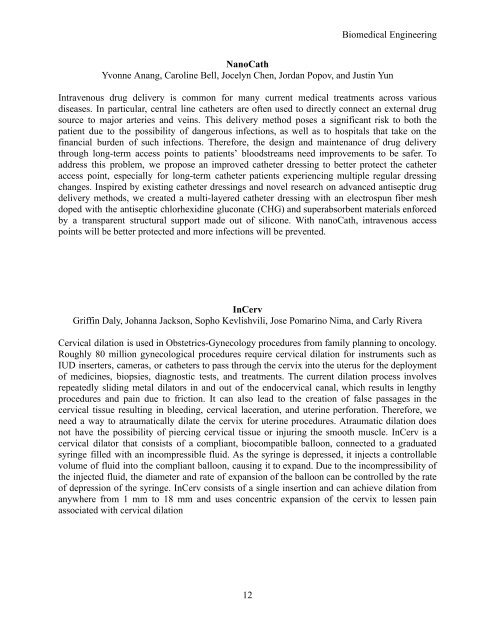You also want an ePaper? Increase the reach of your titles
YUMPU automatically turns print PDFs into web optimized ePapers that Google loves.
Biomedical Engineering<br />
NanoCath<br />
Yvonne Anang, Caroline Bell, Jocelyn Chen, Jordan Popov, and Justin Yun<br />
Intravenous drug delivery is common for many current medical treatments across various<br />
diseases. In particular, central line catheters are often used to directly connect an external drug<br />
source to major arteries and veins. This delivery method poses a significant risk to both the<br />
patient due to the possibility of dangerous infections, as well as to hospitals that take on the<br />
financial burden of such infections. Therefore, the design and maintenance of drug delivery<br />
through long-term access points to patients’ bloodstreams need improvements to be safer. To<br />
address this problem, we propose an improved catheter dressing to better protect the catheter<br />
access point, especially for long-term catheter patients experiencing multiple regular dressing<br />
changes. Inspired by existing catheter dressings and novel research on advanced antiseptic drug<br />
delivery methods, we created a multi-layered catheter dressing with an electrospun fiber mesh<br />
doped with the antiseptic chlorhexidine gluconate (CHG) and superabsorbent materials enforced<br />
by a transparent structural support made out of silicone. With nanoCath, intravenous access<br />
points will be better protected and more infections will be prevented.<br />
InCerv<br />
Griffin Daly, Johanna Jackson, Sopho Kevlishvili, Jose Pomarino Nima, and Carly Rivera<br />
Cervical dilation is used in Obstetrics-Gynecology procedures from family planning to oncology.<br />
Roughly 80 million gynecological procedures require cervical dilation for instruments such as<br />
IUD inserters, cameras, or catheters to pass through the cervix into the uterus for the deployment<br />
of medicines, biopsies, diagnostic tests, and treatments. The current dilation process involves<br />
repeatedly sliding metal dilators in and out of the endocervical canal, which results in lengthy<br />
procedures and pain due to friction. It can also lead to the creation of false passages in the<br />
cervical tissue resulting in bleeding, cervical laceration, and uterine perforation. Therefore, we<br />
need a way to atraumatically dilate the cervix for uterine procedures. Atraumatic dilation does<br />
not have the possibility of piercing cervical tissue or injuring the smooth muscle. InCerv is a<br />
cervical dilator that consists of a compliant, biocompatible balloon, connected to a graduated<br />
syringe filled with an incompressible fluid. As the syringe is depressed, it injects a controllable<br />
volume of fluid into the compliant balloon, causing it to expand. Due to the incompressibility of<br />
the injected fluid, the diameter and rate of expansion of the balloon can be controlled by the rate<br />
of depression of the syringe. InCerv consists of a single insertion and can achieve dilation from<br />
anywhere from 1 mm to 18 mm and uses concentric expansion of the cervix to lessen pain<br />
associated with cervical dilation<br />
12








